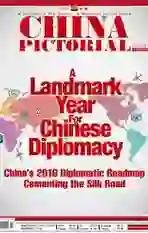Navigating the Great Renewal
2016-03-16byXinhua
by+Xinhua
Three years ago, Xi Jinping, General Secretary of the Central Committee of the Communist Party of China (CPC), met the press from home and abroad just after the formation of Chinas new-generation central leadership, where he pledged that the responsibility of the leading body was to unite and lead the whole Party and people of all ethnic groups, take the relay baton of history, and carry on exhaustive endeavors to complete the great renewal of the Chinese nation and see it rank among the most advanced countries in the world by producing new, great contributions to mankind.
In July 2014, a forum was held featuring specialists on the economic situation in China. Attending Chinese state leaders reached a consensus that top priority would be placed on development and that the country must make unremitting efforts to promote healthy and sustainable economic growth.
By that time, the world was still slowly recovering seven years after the financial crisis. Advanced economies became more divided, and emerging economies endured setbacks over and over amidst economic progress. China was no different: It struggled with the structural contradiction between the new engine for its economic growth and the traditional.
After comprehensive analysis of the characteristics of the worlds economic drought and Chinas development stage, decision makers in the Chinese government realized that they should learn about the “new normal,” adapt to the “new normal,” and guide the “new normal,” which has become the “driving logic” to guide the countrys economic development today with an eye on tomorrow.
For three years, Chinese top decision makers have boosted the countrys economy by innovating macro control methods to cope with the “new normal” of economic development such as shifting focus from demand-side to supply-side economics. They have enhanced the adaptation ability and flexibility of supply systems to upgrade total factor productivity through the measures of dropping capacity, reducing volumes, relieving pressure, and cutting costs.
Driving economic development with innovation has become consensus in China.
In his 2015 government report, Premier Li Keqiang called for a mobilization of the wisdom and talent of hundreds of millions of people to herald a new tide of innovation. At the end of 2015, in the proposal for the 13th Five-Year Plan, the idea of “innovation serves as the first motive force for development” was put forward. Today, the tides of entrepreneurship and innovation are sweeping across the country, becoming one of the “twin engines” for the economic development in an era of the “new normal.”
Statistics reveal that in 2015, more than 11,000 enterprises were formed daily in China, on average. Consumption has contributed 60 percent of national economic growth, over 50 percent of which came from the service industry. Hi-tech is growing faster than anything else industrially. New economic growth points emerge one after another. Entrepreneurship and innovation serve as the new engines for the countrys economic growth. China has led the world with its 30-percent contribution to global economic growth.
Chinese President Xi Jinping advo- cated building the Silk Road Economic Belt and the 21st-Century Maritime Silk Road, which brought a wealth of positive feedback and participation from over 60 countries and international organizations.
In addition, China has arranged joint efforts with its neighboring countries to promote the construction of economic corridors linking China with countries such as Pakistan, Mongolia, Russia, Bangladesh, India, and Myanmar. The Belt and the Road are like the ribbons of a rainbow, tightening the destiny of 4.4 billion people so they can share opportunities for development as well as achievements in development.
China is also actively preparing for the establishment of the Asian Infrastructure Investment Bank, and signed free trade zone agreements with countries including South Korea and Australia in 2015.
China maintains myriad friendly relationships around the world. Today, it has established partnerships in various degrees with 67 countries and regional organizations, weaving a network of global partnership.
In late November 2015, the International Monetary Fund (IMF) announced the inclusion of the RMB (CNY) in the Special Drawing Rights (SDR) basket. As British Prime Minister David Cameron admitted, China is playing a more important role in the United Nations, the G20, and the IMF, and its views on the international system have become more decisive.
Three years have passed since the newgeneration central leadership took office. Thanks to tireless efforts across 1,000 days and nights, the large wheel that is China keeps rolling ahead towards the final destination of the great revival of the Chinese nation.
